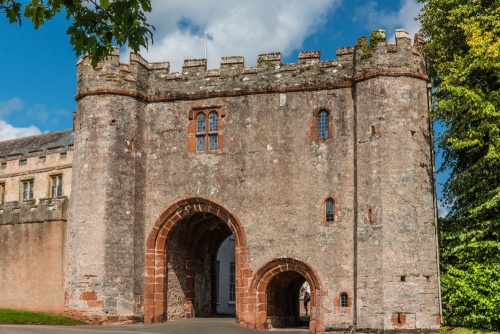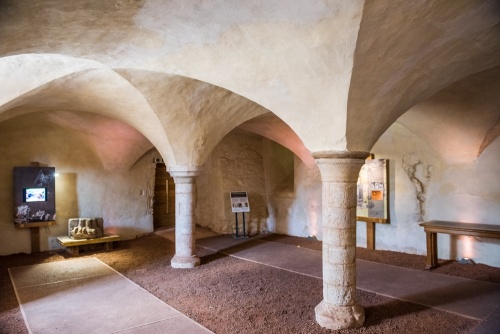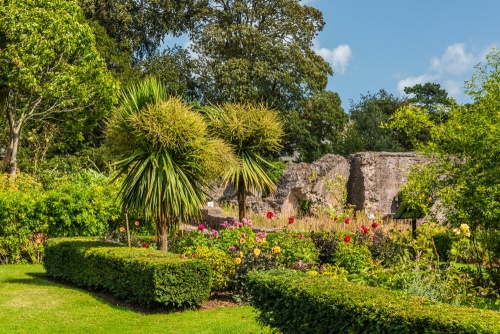
Torre Abbey is a remarkable complex of historical buildings including a 12th-century monastery and an opulent Georgian stately home built from the monastic ruins. The Abbey is set in grounds that include a medieval barn and gateway and a Victorian garden. The former stately home is now the setting for the Torre Abbey Museum, covering life in Torquay over the centuries.
History
The story of Torre Abbey begins over 800 years ago with William Brewer, the lord of the manor of Torre, a small settlement on the south Devon coast. In 1196 Brewer gave land at Torre to the Premonstratensian abbey in Welbeck, Nottinghamshire. The canons of Welbeck sent six of their number under an abbot to establish a new monastery at Torre.
The canons used stone quarried from the nearby headland to create what would become the wealthiest and most important Premonstratensian abbey in England. The wealth of Torre Abbey was one of the factors that helped Torquay grow to its present size and importance. Today the abbey ruins make up the most complete example of a monastic site in Cornwall and Devon.

Torre Abbey survived until 1539 when it was one of the last monasteries in Britain to be suppressed by Henry VIII. The king also took the roofing lead for his own use. The monastic buildings were sold to John St Leger in 1543 and passed through two more owners before Thomas Ridgeway transformed the monastic west range into a comfortable dwelling. The real transformation of Torre Abbey, however, had to wait until the estate was purchased by Sir George Cary in 1662.
Over the next century the Cary family remodelled the medieval abbey buildings into a sumptuous stately home, one of the finest in Devon.
The Cary's did not tear down the monastic buildings and start fresh, but instead, they incorporated them into an elegant new home in fashionable neo-classical style. So as you explore the house and museum you find yourself passing from glittering 18th-century staterooms into dim and dusty medieval chambers.

Near the entrance is the original medieval undercroft, with carvings and effigies found during excavation work. The entrance passage boasts traces of a 13th-century wall painting.
Torre Abbey became a magnet for the great and the good of British society. On one occasion the Cary's entertained Admiral Nelson, and the dinner party is recreated in the Dining Room, with the aid of digital 'talking' dinner plates.
But the glory days of Torre Abbey did not last, and in 1930 the house and grounds were purchased by Torbay Borough Council.
The stately home was transformed once more, this time into an outstanding museum of local history, covering the growth of Torquay and the surrounding area, with an exceptional collection of fine art housed in elegant Georgian rooms. Over 600 works of art are on display, including paintings and sculpture of the highest quality.

Pre-Raphaelite Treasures
One highlight is the Burne-Jones Collection, where you can enjoy several of the original sketches and designs made by Edward Burne-Jones for his 'The Planets' series of stained glass windows. Another Pre-Raphaelite work is 'The Children's Holiday' by Holman Hunt. Look for a proof set of William Blake's 'The Book of Job'.
Frederick Thrupp
Torre Abbey boasts a remarkable collection of plaster reliefs, busts, statues and bronze sculptures by the Victorian sculptor Frederick Thrupp (1812-1895). This is thought to be the largest surviving collection from a 19th-century sculptor's studio. Much of Thrupp's work was intended for use in cemeteries or other types of commemoration, such as his memorial to William Wordsworth in Westminster Abbey.
The 800 Years Gallery, housed in the former servants' bedrooms at the top of the mansion, is a wonderful mixture of interactive displays, portraits, art and historical artefacts telling the story of Torre Abbey from 1196 to the present day.
The Dartmoor Gallery showcases landscape paintings of Dartmoor, while the Call of the Sea Gallery has a large collection of maritime art including many paintings depicting the area around Tor Bay.

The Spanish Barn
Around 1200 the canons of Torre Abbey built a large tithe barn to store tithe offerings (taxes paid in kind, such as perishable goods like grain). The barn survived the Reformation, and in 1588 it had its moment on the stage of history.
When the Spanish Armada floundered in its attempt to invade England, one of the first Spanish ships to be captured was the Nuestra Senora del Rosario. The ship was towed to Torbay and the crew were set on shore under the guard of cavalrymen from St Marychurch.
Sir Francis Drake sent the ship's commander, Don Pedro de Valdes, to Queen Elizabeth, but the rest of the 397 crewmen were held in the former tithe barn at Torre Abbey. That makes the Spanish Barn the only surviving Armada prison in England.
The local inhabitants were understandably hostile, and there were angry scenes outside the barn. A local farmer kindly gave the prisoners some food, but when his generous deed was discovered the farmer was hanged from a nearby tree without ceremony.
Authorities feared - with some justification - that worse would follow if the prisoners were not moved elsewhere with all speed. After just a fortnight in the Barn, the prisoners were divided by social class and dispersed to several locations. Some were imprisoned in Exeter, some held aboard their former ship and others in a military prison.

Over time the actual events were forgotten and several gruesome tales began to be told about the Spanish Barn and its prisoners. It was said that the Spanish were starved to death in the barn and that it was nearly filled with dead bodies. Other stories said that skulls and bones were often dug up and that after a failed escape attempt 'the blood of the Spaniards ran like water' down the steep lane between St Marychurch and Upton.
Not surprisingly, it was later claimed that the ghosts of the dead Spanish soldiers haunted the barn. An even more farfetched legend arose, of a Spanish Lady who, not willing to part from her lover, wore male clothing and sailed with the Armada. The tragic couple died in the Spanish Barn, bt the Lady's spectre can still be seen, gliding along the lane.
The truth is that the Spanish soldiers were generally treated well, certainly by the standards of the time. Some 15 men died of their wounds or exposure during the fortnight they were held in the Spanish Barn, but most were quickly repatriated to Spain.
There are two more popular ghost stories related to Torre Abbey. One unlikely tale says that a medieval abbot beheaded one of his canons and hid the body. The headless cleric's spirit is said to gallop around the grounds on a ghostly horse.
The final ghost story says that the smiling spectre of Lady Cary, a former owner, is driven through the grounds in a brightly illuminated coach, dressed in an exquisite ball gown.
The Gardens
Behind the Cary's mansion are ruins of the medieval monastery buildings that were not incorporated into the new residence. You can still see large sections of the abbey church, with the founder's tomb set into the turf in front of the high altar.
Beyond the monastery ruin is a wonderful Victorian garden with a hothouse for exotic plants and formal garden beds. One part of the formal gardens is given over to Agatha Christie, who grew up in Torquay and lived for many years at nearby Greenway. The garden is divided into four parts, each featuring plants used by Agatha Christie in one of her books. Christie was a qualified pharmacy assistant and used her knowledge of poisonous plants and medicines in over half of her mystery novels.

Getting There
The main entrance to the Abbey is off Avenue Road, but the car park is at the Riviera International Centre. on Chestnut Avenue. We were lucky enough to find parking on Avenue Road, just a few minutes stroll to the Abbey.
Torre Abbey is open daily and there is an admission fee. Our family had a wonderful time exploring the museum, the historic abbey ruins, and the outstanding gardens.
About Torre Abbey
Address: The King's Drive,
Torquay,
Devon,
England, TQ2 5JE
Attraction Type: Abbey
Location: At the junction of the King's Drive, Chestnut Avenue and Avenue road (the A3022, Parking at the Riviera International Centre.
Website: Torre Abbey
Location
map
OS: SX907638
Photo Credit: David Ross and Britain Express
HERITAGE
 We've 'tagged' this attraction information to help you find related historic attractions and learn more about major time periods mentioned.
We've 'tagged' this attraction information to help you find related historic attractions and learn more about major time periods mentioned.
Find other attractions tagged with:
NEARBY HISTORIC ATTRACTIONS
Heritage Rated from 1- 5 (low to exceptional) on historic interest
Kirkham House - 2.1 miles (Historic Building) ![]()
Compton Castle - 2.6 miles (Historic House) ![]()
Berry Pomeroy Castle - 4.1 miles (Castle) ![]()
Stoke Gabriel Church - 5.5 miles (Historic Church) ![]()
Torbryan, Holy Trinity Church - 5.6 miles (Historic Church) ![]()
Bradley Manor House - 5.7 miles (Historic House) ![]()
Greenway - 5.9 miles (Historic House) ![]()
Totnes, St Mary's Church - 6.8 miles (Historic Church) ![]()












